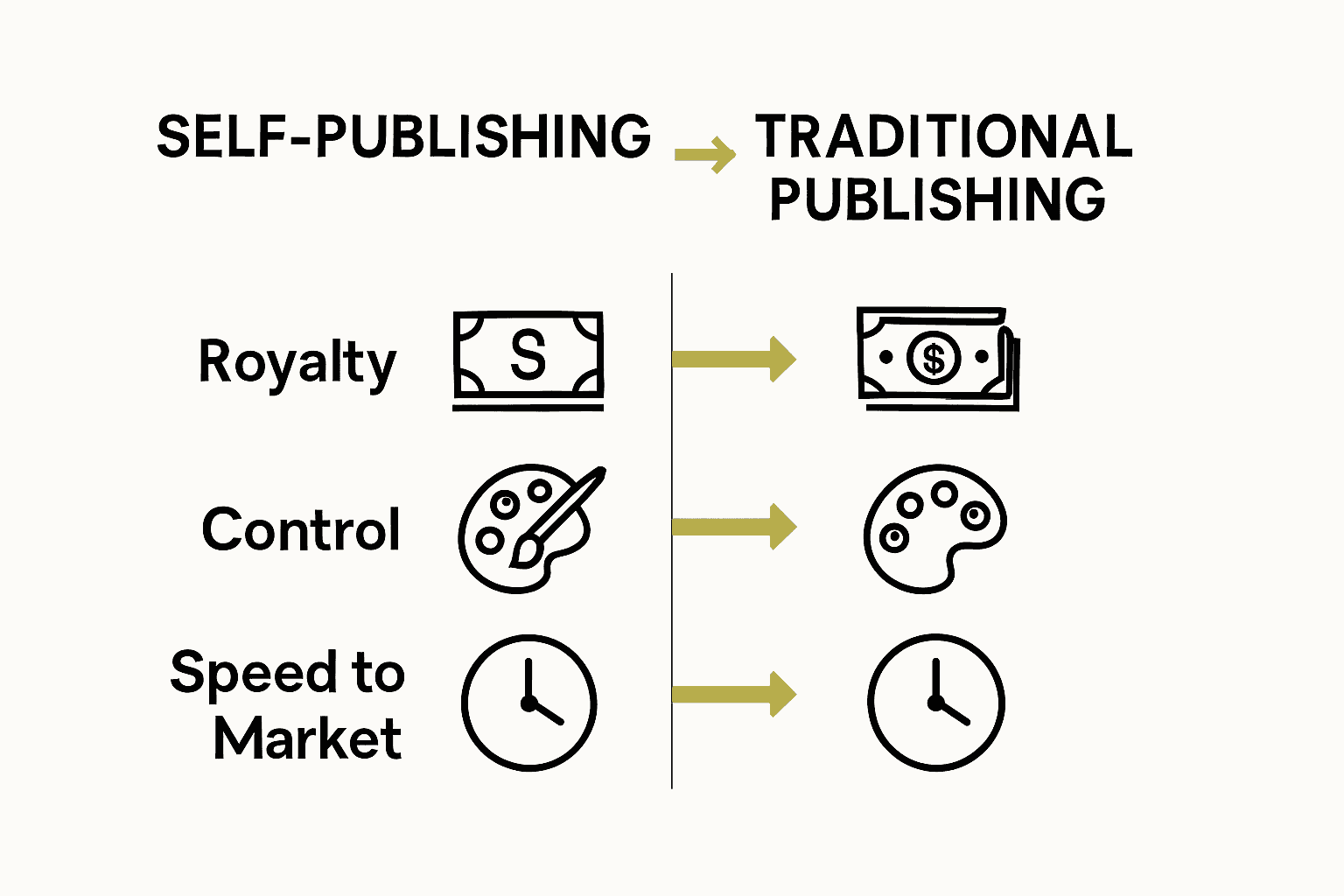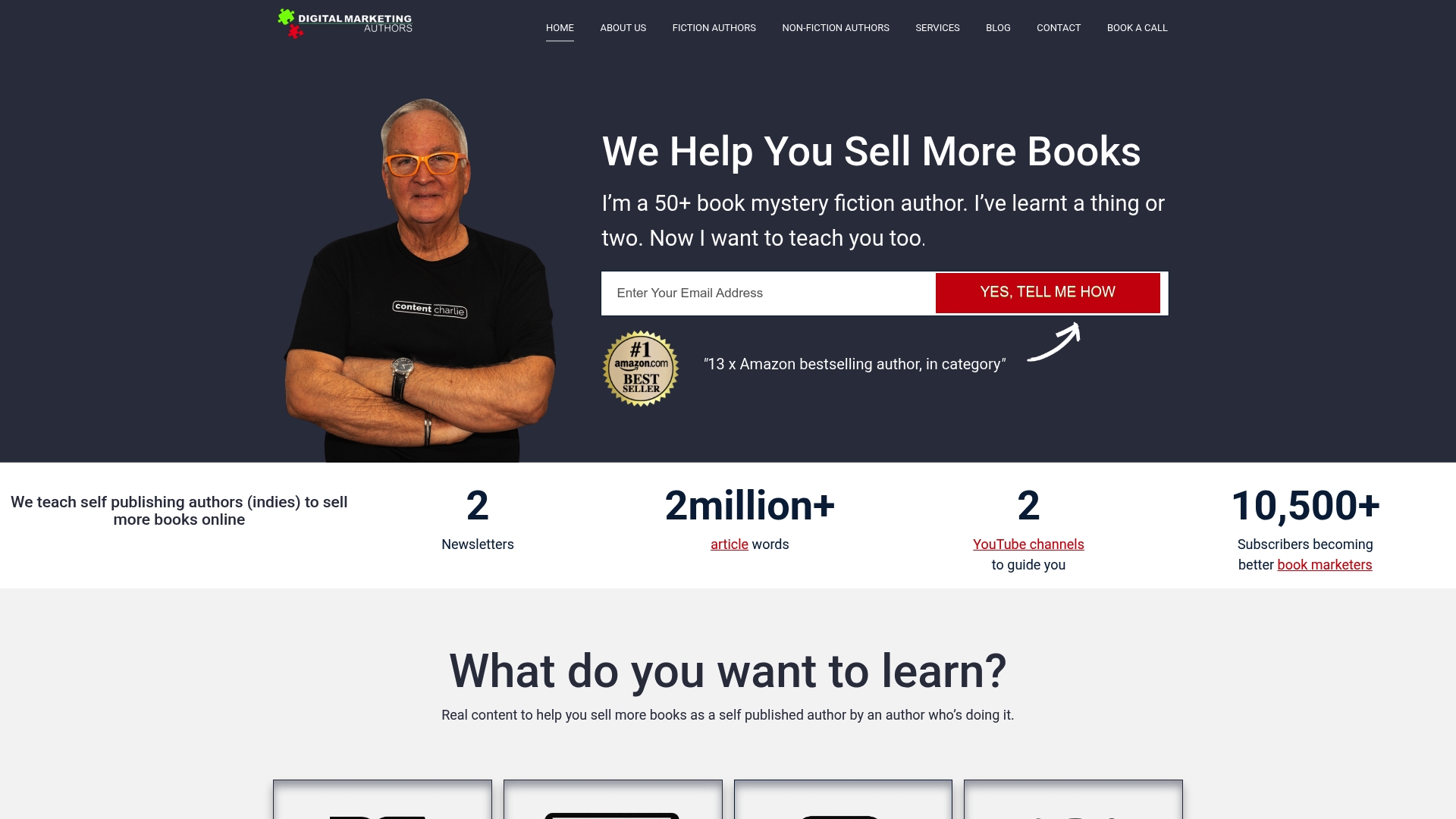- You are here:
- Home »
- Uncategorized »
- Why Self Publishing Works: Complete Author’s Guide

Why Self Publishing Works: Complete Author’s Guide
Did you know that nearly half of self-published authors earn over $20,000 each year from their books? The world of self-publishing is expanding fast, giving writers real financial potential and creative freedom that traditional publishing rarely offers. Understanding both the opportunities and challenges of this path can help you navigate the myths and make smarter decisions for your book’s success.
Key Takeaways
| Point | Details |
|---|---|
| Author Control | Self-publishing grants authors complete creative and business control over their work, from editing to marketing. |
| Financial Advantages | Authors can earn higher royalties (35-70%) compared to traditional publishing (8-15%), increasing their overall income potential. |
| Quality Challenges | Despite the benefits, authors must invest in professional services like editing and design to maintain quality in a competitive market. |
| Market Speed | Self-publishing allows for faster time to market, enabling authors to respond swiftly to trends and feedback. |
Table of Contents
- Self Publishing Defined: Core Concepts And Myths
- Types Of Self Publishing Platforms Explained
- How Self Publishing Empowers Author Control
- Financial Realities: Royalties, Costs, And Earnings
- Comparing Self Publishing And Traditional Publishing
- Common Pitfalls And How To Succeed
Self Publishing Defined: Core Concepts and Myths
Self-publishing represents a powerful revolution in book production where authors take complete control of their publishing journey. Unlike traditional publishing routes, self-publishing allows writers to bypass corporate gatekeepers and directly connect with readers through digital platforms and print-on-demand technologies.
According to research from The Guardian, this publishing model has significant economic potential. A 2023 survey revealed remarkable income opportunities: nearly half of self-published authors earned over $20,000, with 28% surpassing $50,000 in annual book revenue. This data challenges traditional publishing narratives about financial sustainability for writers.
Key characteristics of indie publishing include:
- Complete creative control
- Higher royalty percentages
- Faster time to market
- Direct reader engagement
- Flexible pricing strategies
However, self-publishing isn’t without challenges. While democratizing book production, the market faces quality concerns due to reduced editorial gatekeeping. Successful published authors must invest in professional editing, cover design, and strategic marketing to stand out in an increasingly crowded marketplace. Self Publish Archives offer deeper insights into navigating these nuanced publishing landscapes.
Types of Self Publishing Platforms Explained
Indie publishing platforms have revolutionized how authors bring their work to market, offering multiple avenues to transform manuscripts into published books. According to research from Wikipedia, these platforms range from direct DIY digital publishing to more complex service models that provide comprehensive support for writers.
Print-on-demand technology has been a game-changer in non traditional publishing. This innovative approach allows authors to print books only when orders are placed, dramatically reducing upfront inventory costs and financial risk. With best self-publishing platforms, writers can now distribute books globally without maintaining expensive print inventories.
The primary types of self-publishing platforms include:
- DIY Digital Platforms: Direct online publishing with minimal support
- Assisted Self-Publishing: Bundled services with professional guidance
- Hybrid Publishing: Cost-sharing models with partial publisher involvement
- Print-on-Demand Services: Technology-driven printing solutions
Each platform offers unique advantages, but authors must carefully evaluate their specific needs. While some platforms provide extensive marketing support, others focus purely on distribution. Understanding the nuanced differences helps writers select the most appropriate publishing route for their individual goals and budget constraints.
How Self Publishing Empowers Author Control
Author autonomy has been dramatically transformed by indie publishing, giving writers unprecedented control over their creative and professional journeys. According to research from Best Seller Ghostwriting, self-publishing enables creators to make independent decisions about every aspect of their book’s production and distribution.
Traditional publishing barriers have been dismantled, allowing authors to retain complete creative freedom. Self Publish A Book To Boost Your Career highlights how writers can now control critical elements like:
- Book cover design
- Pricing strategies
- Release timelines
- Marketing approaches
- Content editing
The most transformative aspect of self-publishing is its rapid turnaround potential. Authors can potentially complete their entire publishing process in under 90 days, compared to the years-long traditional publishing cycle. This speed empowers writers to respond quickly to market trends, reader feedback, and their own creative impulses, turning publishing from a gatekept process into a dynamic, author-driven experience.
Financial Realities: Royalties, Costs, and Earnings
Self-publishing economics represent a dramatic shift from traditional publishing models, offering authors significantly more favorable financial opportunities. According to research from The Guardian, a 2023 survey of 2,000 self-published authors revealed impressive income potential: nearly half earned over $20,000, with 28% surpassing $50,000 in annual book revenue.
Royalty structures in self-publishing are substantially more lucrative compared to traditional publishing.
 17 Best Self Publishing Companies In 2025 highlights that self-published authors typically earn between 35-70% royalties, compared to traditional publishing’s meager 8-15% range. This dramatic difference means authors retain more of their book’s earnings.
17 Best Self Publishing Companies In 2025 highlights that self-published authors typically earn between 35-70% royalties, compared to traditional publishing’s meager 8-15% range. This dramatic difference means authors retain more of their book’s earnings.
Key financial considerations for self-published authors include:
- Initial production costs (editing, cover design)
- Platform-specific fee structures
- Marketing and promotional expenses
- Potential for higher per-book earnings
- Flexibility in pricing strategies
Successful self-publishing requires treating your book as a business. While the potential for substantial earnings exists, authors must be prepared to invest in professional editing, compelling cover design, and strategic marketing to maximize their book’s financial potential and reader appeal.
Comparing Self Publishing and Traditional Publishing
Publishing pathways represent two distinct approaches for authors seeking to bring their work to readers. According to research from Best Seller Ghostwriting, each route offers unique advantages and challenges that writers must carefully evaluate.
Traditional publishing provides established infrastructure and professional support, including advance payments and industry connections. In contrast, self-publishing empowers authors with complete creative control and significantly higher royalty rates. Self-publishing companies highlight the dramatic differences in financial potential, with self-published authors typically earning 35-70% royalties compared to traditional publishing’s 8-15%.
Key comparative elements include:
Here’s a side-by-side comparison of self-publishing and traditional publishing models:
| Factor | Self-Publishing | Traditional Publishing |
|---|---|---|
| Creative Control | Full author autonomy | Publisher-driven decisions |
| Royalty Percentage | 35-70% | 8-15% |
| Speed to Market | Weeks to months | 1-2 years |
| Upfront Costs | Author-funded | Publisher-funded |
| Distribution | Author-managed | Established networks |
| Marketing | Author responsibility | Publisher support (varies) |
- Speed to Market: Self-publishing (weeks) vs Traditional (years)
- Creative Control: Full author autonomy vs Publisher-driven decisions
- Financial Investment: Author-funded vs Publisher-funded
- Royalty Percentages: Higher (self-publishing) vs Lower (traditional)
- Distribution Channels: Author-managed vs Established publishing networks
Ultimately, the choice between self-publishing and traditional publishing depends on an author’s specific goals, resources, and willingness to manage their own publishing journey.
 While traditional publishing offers prestige and established support, self-publishing provides unprecedented freedom and potential for direct reader engagement.
While traditional publishing offers prestige and established support, self-publishing provides unprecedented freedom and potential for direct reader engagement.
Common Pitfalls and How to Succeed
Self-publishing success requires more than simply uploading a manuscript to an online platform. According to The Guardian, the current publishing landscape is incredibly crowded, with millions of titles competing for reader attention.
Authors must approach self-publishing as a professional endeavor, not just a creative outlet. Professional production quality becomes critical—this means investing in:
- High-quality cover design
- Professional editing
- Targeted marketing strategies
- Consistent author branding
- Strategic pricing and distribution
The most common mistakes self-published authors make involve underestimating the business side of publishing. Email Marketing Archives suggest that building a robust reader communication strategy is just as important as the book itself. Successful self-publishers treat their books like a business, continuously learning, adapting, and investing in their craft and market understanding. Visibility isn’t guaranteed—it’s earned through persistent, strategic effort and a commitment to producing exceptional work that resonates with your target readers.
Ready to Master Self Publishing and Grow Your Author Brand?
You already know self publishing gives you creative control and better royalties, but turning your manuscript into a bestseller takes more than just uploading your book. If you feel overwhelmed by marketing, building a loyal reader base, or using the right technology to cut through competition, you are not alone. Many writers hit the same roadblocks featured in our guide: standing out, connecting with readers, and creating reliable book sales.

Now is the perfect time to transform your strategy and reach more readers. Discover how Digital Marketing Authors makes it simple to automate sales, grow your fanbase, and scale your author business with proven digital marketing and AI solutions. If you are ready to take charge of your publishing results instead of relying on luck or noisy marketplaces, visit our site for expert guidance. Claim your path to sustainable book profits and author independence today.
Frequently Asked Questions
What are the key advantages of self-publishing for authors?
Self-publishing offers several significant advantages, including complete creative control, higher royalty rates (35-70% vs 8-15% in traditional publishing), a faster time to market, and the opportunity for direct engagement with readers.
What challenges do self-published authors face?
Self-published authors often encounter challenges such as quality control issues due to reduced editorial oversight, the need for professional services (like editing and cover design), and the responsibility of handling marketing and distribution themselves.
How do self-publishing royalties compare to traditional publishing royalties?
Self-published authors typically earn between 35-70% in royalties, while traditional publishers generally offer only 8-15%. This substantial difference highlights the financial benefits of self-publishing for authors.
What are the primary types of self-publishing platforms available?
The main types of self-publishing platforms include DIY digital platforms for direct publishing, assisted self-publishing services that offer professional support, hybrid publishing models that involve shared costs, and print-on-demand services that print books as orders are placed.

